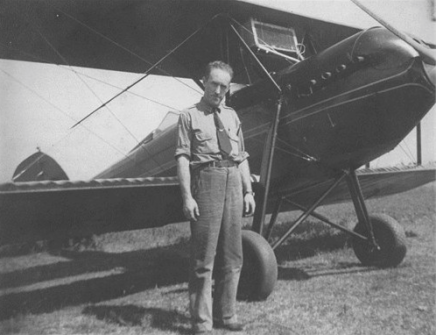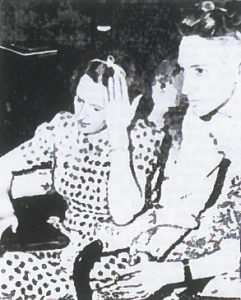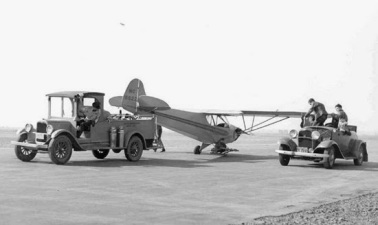

![Goldie Gehrken, the Illinois girl whom Pletch romanced in the summer of 1939 after making off with a stolen aircraft. Photo from the Danville [VA] Bee.](https://allkindsofhistory.files.wordpress.com/2014/12/goldie-gehrken.png?w=200&h=405)
The precise circumstances of the Bivens murder are rendered hazy by the endless lies that Pletch spun after the shooting. It seems, though, that he had rejoined the Royal American Shows and that it was the carnival that took him to Missouri – where, in September 1939, he married one Francis Bales, of Palmyra. She may have met him at the fair, and she was, apparently, his third wife. Whatever the truth, the marriage didn’t last. Bales left Pletch after only a few days – one source says that he robbed her – and not much more than a month later, after borrowing a car in which he searched unsuccessfully for his missing wife, he did something just as impulsive, but with vastly more serious consequences. He pitched up in the little town of Brookfield and asked Carl Bivens to teach him to fly.
Pletch took two lessons on the cool autumn afternoon of 28 October, and they went well enough for him to request a third flight in the little yellow Taylor Club monoplane that Bivens had borrowed from a friend. It was 40 minutes into that third session, while “zipping along” at about 5,000 feet, that the instructor was murdered.
Pletch’s motive for killing Bivens was never really clear. He gave several different versions of events, saying at one point that he had plotted to steal the plane in order to use it to test his inventions – which supposedly included a new sort of high-performance aviation fuel – and at another, in an account that was rather plainly intended to reduce the charge he faced from first to second degree murder, that he and the instructor had agreed to abscond together in the plane and head for Mexico.

In this version of events, Bivens had tried to back out of the deal while in mid air above Missouri. Pletch’s story was that the two men had argued – “I told him that he was not going to double-cross me” – and that Bivens had reached back and attempted to grapple with him, losing control of the plane in the process. It was only because he feared that they were about to crash, Pletch said, that he drew his gun and fired. The best evidence that this was simply a lie can be found in the killer’s own account; having claimed that he acted in a panic to save his own life, Pletch went on to concede that the emergency only really began after he had shot the pilot: “The ship began to pitch and then to dive,” he claimed. “I remembered reading about a dying man ‘stiffening at the controls,’ and then I fired another shot… I reached forward and pulled his body away from the controls, and after a few seconds I got the plane straightened out.”
Given the seating arrangement in the plane (Bivens was seated directly in front of Pletch, and also had to fly the aircraft, meaning that he was scarcely in a position to seriously threaten his student), this last story rings spectacularly false. It seems much more likely that the murder was nothing more than a means to an end, and that Pletch was simply doing what he had already done once before – stealing a plane and fleeing his responsibilities, albeit in a startlingly strange and brutal manner. He seems to have hinted as much in what was probably the closest that he ever came to telling the truth, a statement made to prosecutors in Missouri:
Carl was telling me that I had a natural ability, and I should follow that line [a career in aviation]. I had a revolver in my pocket and without saying a word to him, I took it out of my overalls and I fired a bullet into the back of his head. He never knew what struck him.
Having landed briefly in order to dispose of Bivens’s body – which he did, after relieving the dead man of his wrist watch and several hundred dollars in cash, by dumping it in a cow pasture near Cherry Box, Missouri – Pletch flew north. He landed in another field as it grew dark, spending the night in a barn and moving on first thing in the morning. He was heading, apparently, for his parents home, and even circled over it – but, having decided against the kamikaze plan of crashing into his father’s barn, he landed instead in a field in Clear Creek, just outside the central Indiana town of Bloomington. It was dusk by then, and just over a day since the murder: plenty of time for Bivens’s body to be discovered and for word of the stolen plane to spread through the Midwest.

The first people in Clear Creek to notice the plane’s approach were two young children, Bobby Joe Logsdon, who was six years old, and his brother Jimmy, seven. The boys had been doing the chores when they heard the sound of an engine overhead. Bobby Joe, who was “crazy about aviation,” just like Pletch, had never seen or heard a plane at such close quarters, but his father would not allow him to run out to touch the aircraft as he wanted to. Plenty of others did hurry to the site, however – nothing quite so exciting had happened in the little farming community for years – and when Pletch climbed down from the cockpit and asked if there was anywhere nearby to eat, they pointed him in the direction of the Williams & Wampler General Store, which had a lunch counter that served hamburgers and coffee.
There was still enough light for several of the locals crowding around the plane to notice something suspicious about the pilot: there was blood on the front of his blue overalls. Pletch explained the stains away by saying that it came from “a nosebleed that he got from the altitude,” but word of his arrival quickly reached Clear Creek’s telephone operator, Bertha Manner, and she had been listening to her radio when it reported a sighting of Pletch’s stolen yellow aeroplane as it circled over Frankfort. Manner, who prided herself on her “vivid imagination and a nose for news,” lost no time in calling the Bloomington police.
Interviewed by a local reporter 70 years after the events of that exciting evening, Bobby Joe Logsdon recalled that the phone soon rang in the general store:
“Bill Wampler answered it. The deputy instructed Bill to say only ‘yes’ and ‘no’ in response to his questions. He asked if the pilot was there, then if Bill could stall him, but not to do anything foolish because the man was dangerous. Bill was frying the hamburgers for the pilot. He was a nervous, jittery kind of a guy, but he just scooted the burgers over to the cool part of the grill so they wouldn’t cook so fast.”
Thanks to Wampler’s quick thinking, Pletch was still in the middle of his meal when the state and local police arrived and surrounded the building. He gave up without a fight, turned over his pistol, and was led away from the store in handcuffs. Interviewed in Monroe County Jail, he made much of his love for aircraft. “I would rather fly than eat,” he said.
The case threatened to establish some interesting legal precedents. It was, to begin with, the first case of highjacking, or “air piracy”, in the United States – the Chicago Tribune termed it “one of the most spectacular crimes of the 20th century, and what is believed to be the first airplane kidnap murder on record.” Since Pletch could not really navigate (and had every incentive, in any case, to fudge the issue), it was also not at all clear exactly where the murder had occurred, and hence where the case ought to be tried. In the course of their lesson, Bivens and Pletch had flown over three Missouri counties, each of which was a separate jurisdiction. That was confusing enough, but – as James L. Robinson, a law professor and director of the Indiana University Institute of Criminal Law pointed out – the statutes in force at the time had not been drafted to take account of killings that took place in mid-air.
“Suppose a murder is committed in an airplane out of sight of land,” Robinson hypothesised,
“making it impossible to prove the county over which the offense occurred. Could the murder be prosecuted, and, if so, where?”
Unfortunately for Earnest Pletch, the prosecutors in Missouri took a much less abstract approach when he was handed over to them next day. There was some potential for a tussle – Fred Bollow, who was the prosecutor for Shelby County, where Bivens’s body had been found, lost little time in filing murder charges. But the plane had spent most of its time in the air over neighbouring Macon County, and Bollow’s colleague there, Vincent Moody – “holding Pletch’s confession authentic as to the murder location” – successfully claimed jurisdiction.
Moody wasted no time in bringing Pletch to court – feelings were running so high in the district that there were fears that he might be lynched if there was any delay – and the killer himself speeded things along by waiving his right to a preliminary hearing. When he was brought into the sparsely attended court on 1 November, he pleaded guilty.
There seems little doubt that this was a legal manouvre designed to give Pletch the best possible chance of avoiding the death penalty, but it was Etta Bivens who did more than anyone to save her husband’s killer from an appointment with the gas chamber. She told the presiding judge, Harry J. Libby, that she did not wish to seek the death penalty. Instead, Libby sentenced Pletch to life – having first extracted a promise that he would never apply for either pardon or parole.
What happened next remained something of a mystery for many years. Pletch certainly lived on, and on, finally dying at the age of 91 in June 2001. That ought to have meant that he served a sentence of almost 62 years in Missouri State Prison, long enough to win him an unwelcome place on the list of the 10 longest sentences ever served in American jails. When Pamela Keech, an Indiana journalist who interviewed the surviving witnesses to his plane’s landing for Bloom magazine in 2009 wrote up her story, she assumed that Pletch had died in jail.
My own research shows that that was not the case. The US Social Security Death Index lists Pletch, but gives the place of his death as Eldridge, Missouri – an isolated spot nowhere near any of the state’s prisons. And a careful search of local newspapers revealed that Pletch’s name cropped up twice among the small ads published by the Kansas City Star years earlier, in 1964 and 1965 – on the first occasion selling a “new ranch type house” together with an associated lot on the Lake of the Ozarks, and on the second auctioning a service station, together with “several items of personal property including boats, motors, café equipment, and some antiques.” Not only that – a man by the name of Earnest Pletch had found employment as a pilot with a firm called Cox Aviation and married a woman named Mary Leap on the day after Christmas 1973. There must have been other wives as well; when this Pletch died, he left 16 grandchildren and 22 great-grandchildren.

It took some correspondence with the Missouri State Archives to resolve the problem – and reveal an outcome that the merciful Etta Bivens surely never intended when she interceded to save Pletch’s life in 1939. The killer, it turned out, had served less than 20 years for the murder of her husband. Pletch had kept his promise not to apply for a pardon or parole, but then he hardly needed to – his life sentence had been commuted to one of 25 years on 9 January 1953, then further commuted on 1 March 1957, the day of his release.
“We looked at the commutation records,” an archivist wrote, “and they do not give any information as to why his sentence was commuted twice… Commutations for convicted murderers or people with life sentences were fairly common. Overcrowding was an endemic problem at the MSP, so prisoners with good behaviour were often let out early.”
There does not seem to be any evidence that Earnest Pletch committed any further crimes after his early release. Perhaps he realised he was lucky. Lucky to have landed the Taylor Club successfully that long ago Friday afternoon with a dead man at the dual controls. Lucky not to have been lynched when he was sent back to Missouri. Lucky, again, to have served his time in a grossly overcrowded jail. But fortunate above all to have been offered mercy by a woman to whose husband he had shown no mercy at all.
Sources
Contemporary newspapers: Capital Times [Madison, WI], 8 Jul 1938; Miami News [FLA], 8 Jul 1939; Daily Republican [Monogahela, PA] 12 Jul 1939; Vidette-Messenger [Valparaiso, IN], 12 Jul 1939; Oshkosh Daily Northwestern, 30 Oct 1939; Sweetwater Reporter, 30 Oct 1939; San Jose Evening News, 30 Oct 1939; Evening Courier (Prescott, AZ), 30 Oct 1939; Montreal Gazette, 30 Oct 1939; Spartenburg Herald, 1 Nov 1939; Joplin Globe, 1 Nov 1939; Ottawa Journal, 2 Nov 1939; and Kansas City Star, 27 Sep 1964 and 13 Jun 1965. Other sources: Private correspondence with Missouri State Archives, July 2014, author’s files; Pamela Keech. “The killer who fell from the sky: a true-life B-town crime story”‘. Bloom [Bloomington, IN], Oct-Nov 2009; Missouri Obituary and Death Notice Archive; United States Social Security Death Index.


